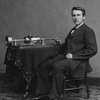Decennial Census Historical Facts
Decennial Census Historical Facts
Censuses are not conducted in a vacuum. They occur amidst internal and external crisis, shifts in cultural interests, and events that become "defining moments" for each decade. Census data reflect the growth of the population as well as the changing values and interests of the American people.
Decennial Historical Facts provides a portrait of the United States both statistically and culturally in the following four areas:
- Pop Culture – key milestones from the decade following the census.
- Population
- Census Details
- 10 Largest Urban Places
1870
ICONS: Yellowstone National Park, George Armstrong Custer, Phonograph



Population
| 38,558,371 |
U.S. Resident Population |
| 11.2 |
Population per square mile of land area |
| 26.6 |
Percent increase of population from 1860 to 1870 |
| 37 |
Number of States |
10 Largest Urban Places
| Rank |
Place |
Population |
|---|---|---|
| 1 |
New York City, NY | 942,292 |
| 2 |
Philadelphia, PA | 674,022 |
| 3 |
Brooklyn, NY | 396,099 |
| 4 |
St. Louis, MO | 310,864 |
| 5 |
Chicago, IL | 298,977 |
| 6 |
Baltimore, MD | 267,354 |
| 7 |
Boston, MA | 250,526 |
| 8 |
Cincinnati, OH | 216,239 |
| 9 |
New Orleans, LA | 191,148 |
| 10 |
San Francisco, CA | 149,473 |
The 1870 Census
| Cost | $3,421,000 |
| Cost per Capita (cents) | 8.8 |
| Total Pages in Published Reports | 3,473 |
| Number of Enumerators | 6,530 (438 office staff) |
| Census Bureau Director | Francis Amasa Walker |
| Number of Questions on the Questionnaire | 20 |
| Number of Questions on the Long Form | N/A |
Pop Culture
- John D. Rockefeller incorporates the Standard Oil Company. It would eventually become the largest oil company in the world before the U.S. Supreme Court declared it an "unreasonable monopoly" under the Sherman Antitrust Act in 1911.
- The National Weather Service issues its first weather forecast on November 1, 1870. The forecast warns of a windy day in Chicago, IL.
- "The Great Chicago Fire" begins October 8, 1871.
- President Ulysses S. Grant signs legislation designating Yellowstone the first national park on March 1, 1872.
- The Jesse James Gang conduct the first successful train robbery in the American West on July 21, 1873.
- On August 2, 1873, Andrew Hallidie tests the first cable car system in San Francisco, CA.
- The first Kentucky Derby is run at Churchill Downs in Louisville, KY, on May 17, 1875.
- Mark Twain publishes The Adventures of Tom Sawyer in 1876.
- Lt. Colonel George Custer and the 7th U.S. Cavalry battle the Sioux and Cheyenne Indians on the bluffs above the Little Big Horn River, on June 26, 1876.
- Colorado becomes the 38th state on August 1, 1876.
- Although Democrat Samuel J. Tilden wins the popular vote over Republican Rutherford B. Hayes (4,284,020 vs. 4,036,572) during the 1876 presidential election, Hayes wins the electoral vote by promising to loosen Reconstruction's restrictions on the southern states.
- Brigham Young, leader of the Mormon Church, founder of Salt Lake City, UT, and first governor of the Utah Territory, dies August 29, 1877.
- Thomas Edison demostrates the phonograph at the offices of the "Scientific American" on December 7, 1877.
- The Yale News becomes the first daily college newspaper in the United States on January 28, 1878.
- Gilbert and Sullivan's "Pirates of Penzance," premieres at the Fifth Avenue Theatre on December 31, 1879.
Page Last Revised - October 8, 2021




